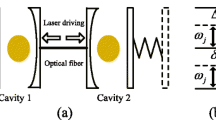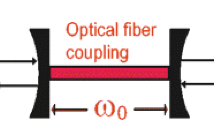Abstract
A scheme is presented to generate entanglement of optical andmechanical modes in coupled cavity optomechanical system with two four-level atoms. Two distant movable mirrors and two cavity modes as well as mirror and the adjacent or the distant cavity mode are all entangled, and the entanglement curve of two movable mirrors is a symmetrical distribution when ∆ is equal to ωm. Furthermore, we also investigate the output entanglement of two cavity fields, and find the squeezing spectrum is affected by the mirror frequency and the Rabi frequency of laser field.



Similar content being viewed by others
References
Bouwmeester, D., Ekert, A., Zeilinger, A.: Springer, Berlin (2000)
Nielson, M.A., Chuang, I.L.: Cambridge University, Cambridge (2000)
Massel, F.: Phys. Rev. A 95, 063816 (2017)
Yang, X.H., Yin, Z.Y., Xiao. M.: Phys. Rev. A 99, 013811 (2019)
Teklu, B., Byrnes, T., Khan, F.S.: Phys. Rev. A 97, 023829 (2018)
Liao, C.G., Chen, R.X., Xie, H., Lin, X.M.: Phys. Rev. A 97, 042314 (2018)
Cheng, J., Zhang, W.Z., Han, Y., Zhou, L.: Sci. Rep. 6, 23678 (2016)
Wang, Y.D., Chesi, S., Clerk, A.A.: Phys. Rev. A 91, 013807 (2015)
Liao, J.Q., Wu, Q.Q., Nori, F.: Phys. Rev. A 89, 014302 (2014)
Chen, R.X., Shen, L.T., Yang, Z.B., Wu, H.Z., Zheng, S.B.: Phys. Rev. A 89, 023843 (2014)
Huang, S.M., Chen, A.X.: Phys. Rev. A 98, 063843 (2018)
Chakraborty, S., Sarma, A.K.: Phys. Rev. A 97, 022336 (2018)
Zhou, L., Cheng, J., Han, Y., Zhang, W.P.: Phys. Rev. A 88, 063854 (2013)
Chauhan, A.K., Biswas, A.: Phys. Rev. A 95, 023813 (2017)
Mann, N., Thorwart, M.: Phys. Rev. A 98, 063804 (2018)
Li, X.Y., Nie, W.J., Chen, A.X., Lan, Y.H.: Phys. Rev. A 96, 063819 (2017)
Zhou, L., Han, Y., Jing, J.T., Zhang, W.P.: Phys. Rev. A 83, 052117 (2011)
Zhang, Q.K., Zhang, X.Y., Liu, L.Z.: Phys. Rev. A 96, 042320 (2017)
Teklu, B., Byrnes, T., Khan, F.S.: Phys. Rev. A 97, 023829 (2018)
Mckeever, J., Boca, A., Boozer, A.D., Buck, J.R.: Nature (London) 425, 268 (2003)
Cho, J., Angelakis, D.G., Bose, S.: Phys. Rev. A 78, 022323 (2008)
Scully, M.O., Zubairy, M.S.: Quantum Optics. Cambridge University Press, London (1997)
Vitali, D., Gigan, S., Ferreira, A., Böhm, H.R., Tombesi, P., Guerreiro, A., Vedral, V., Zeilinger, A., Aspelmeyer, M.: Phys. Rev. Lett. 98, 030405 (2007)
DeJesus, E.X., Kaufman, C.: Phys. Rev. A 35, 5288 (1987)
Genes, C., Mari, A., Tombesi, P., Vitali, D.: Phys. Rev. A 78, 032316 (2008)
Adesso, G., Serafini, A., Illuminati, F.: Phys. Rev. A 70, 022318 (2004)
Marquardt, F., Chen, J.P., Clerk, A.A., Girvin, S.M.: Phys. Rev. Lett. 99, 093902 (2007)
Adesso, G., Illuminati, F.: J. Phys. A: At. Math. Theor. 40, 7821 (2007)
Serafini, A., Adesso, G., Illuminati, F.: Phys. Rev. A. 71, 032349 (2005)
Zhou, L., Mu, Q.X., Liu, Z.J.: Phys. Lett. A. 373, 2017 (2009)
Walls, D.F., Milburn, G.J.: Quantum Optics. Springer, Berlin (2000)
Gröblscher, S., Hammerer, K., Vanner, M.R., Aspelmeye, M.: Nature (London) 460, 274 (2009)
Mazzola, L., Paternostro, M.: Phys. Rev. A 83, 062335 (2011)
Acknowledgments
The project was supported by the NSFC (Grants No.11704042, No. 51702003 and No. 51502005), the Anhui Provincial Natural Science Foundation (No. 1808085ME130).
Author information
Authors and Affiliations
Corresponding author
Additional information
Publisher’s Note
Springer Nature remains neutral with regard to jurisdictional claims in published maps and institutional affiliations.
Appendices
Appendix A: Calculation of the Mean Values
We now calculate the zero order \({\sigma }_{ii^{\prime }}^{j0}\)\((i,i^{\prime }=e,f,g,h,j=1,2)\) in (4). With the help of laser linear approximation theory, the classical fields will be treated to all orders in the Rabi frequency Ω, while the atomic transitions \(|e\rangle \leftrightarrow |g\rangle \) and \(|f\rangle \leftrightarrow |h\rangle \) are treated to first order in the coupling constants g. Including the damping terms, we can obtain the quantum Langevin equations of the atom
Solving steady state solution of above equation, we have the zero order \({\sigma }_{ii^{\prime }}^{j0}\) of the atom as
with
Substituting the zero-order approximation \(\sigma _{ii^{\prime }}^{j0}\) into (A1), σge and σhf can be obtained
All the parameters of another cavity have the same form as the first one. Bring σca and σdb back into (3), we can have the steady solution (5).
Appendix B: Coefficients of the Drift Matrix A
Here we give the concrete form of some elements in drift matrix A.
The other parameters \({I}_{+}^{\prime }, {I}_{-}^{\prime }, {R}_{+}^{\prime }, {R}_{-}^{\prime }, {T}_{+}^{\prime }, {T}_{-}^{\prime }, {G}_{+}^{\prime }, {G}_{-}^{\prime }\) of the second cavity have the same form as the first one.
Rights and permissions
About this article
Cite this article
Pan, G., Xiao, R. & Gao, J. Entanglement and Output Squeezing of Distant Optomechanical Systems Generated by Four-Level Atoms. Int J Theor Phys 59, 1338–1350 (2020). https://doi.org/10.1007/s10773-020-04411-6
Received:
Accepted:
Published:
Issue Date:
DOI: https://doi.org/10.1007/s10773-020-04411-6




